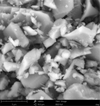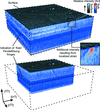issue contents
April 2020 issue

Cover illustration: A graphical representation of conventional ptychography, courtesy of Wakonig et al. [J. Appl. Cryst. (2020), 53, 574–586]. From the article PtychoShelves, a versatile high-level framework for high-performance analysis of ptychographic data.
scientific commentaries
Free 

The paper of Henningsson, Hall, Wright & Hektor [J. Appl. Cryst. (2020), 53, https://doi.org/10.1107/S1600576720001016] published in this journal issue presents a promising diffraction-tomography method for determining strain tensors at sub-micrometre scale in bulk polycrystalline materials.
research papers
Open  access
access
 access
accessMethods for reconstruction of intragranular strain tensor fields for scanning three-dimensional X-ray diffraction (3DXRD) are developed and evaluated.
It is demonstrated how k nearest neighbor machine learning methods can be used to classify small-angle scattering data for the most appropriate model to use for data analysis. The results show the promise of machine learning for helping small-angle scattering practitioners translate measured data into scientific results.
This paper aims to expand the existing knowledge on the partial and repeated B2↔B19′ phase transformation under cyclic loading–unloading, by combining single peak fitting and Rietveld-based analysis.
X-ray diffraction contrast tomography is used to investigate the crystallographic, topological and morphological characteristics of the evolving microstructure in thermally aged strontium titanate samples. The analysis of the 3D structure shows a clear signature of the grain boundary anisotropy, which can be correlated to surface energy anisotropy: the grain boundary orientation distribution function shows an excess of 〈100〉-oriented interfaces with respect to a random structure.
Statistical properties of the dislocation microstructure developing in Mg alloys deformed by compression have been determined by the variance method of X-ray line profile analysis.
The behaviour of IrO2 thin films during annealing in oxygen, nitrogen, forming gas and vacuum was studied using in situ high-temperature X-ray diffraction and X-ray reflectivity, and ex situ scanning electron microscopy and atomic force microscopy.
Phase transitions in relaxor-ferroelectric crystals during conventional sample preparation are investigated by a symmetry study.
The exchange Monte Carlo method is implemented for analyses of surface X-ray scattering.
This article provides a unifying description of the diffraction and signal acquisition geometries of a 3D Bragg coherent diffraction imaging (BCDI) measurement, obtained from fundamental considerations of Fourier-conjugate spaces. Rigorously derived and presented in a compact operator notation, this approach can be easily generalized to any set of BCDI degrees of freedom.
New phase-retrieval methods to directly invert Bragg coherent diffraction imaging data on an orthogonal grid under even and uneven signal sampling conditions are described.
Based on measurements of the contractile strain ratio (CSR) and the textures of three thin-walled Ti–3Al–2.5V tubing samples, a quantitative method is proposed for exploring the correlation between the CSR values and the orientation distribution function data of the tubing samples.
A total-intensity method for amorphous phase quantification is presented, which allows for determining the mass fractions of amorphous components in an alkali-activated slag. The method is applied to determine the unreacted slag in an alkali-activated slag.
Open  access
access
 access
accessProcedures are demonstrated which enable a manual determination of the angles between lattice planes and directions from electron backscatter diffraction patterns of unknown phases. The determination of the projection centre is described for cases where it is unknown.
Open  access
access
 access
accessThe RIKEN compact neutron source and related neutron diffractometer were successfully upgraded for precise in-house texture measurement, as judged by comparison with two other well established neutron diffractometers. This provides a good example for the technical development and the scientific application of neutron diffraction techniques based on compact neutron sources.
The dependence on radius of the melting temperature of dilute sets of spherical nanocrystals with wide radius distributions was determined by a novel procedure exclusively using the results of small-angle X-ray scattering measurements. The same procedure also allowed determination of the thermal expansion coefficients of nanoparticles in both liquid and crystalline phases.
The different random variables that contribute to the final resolution of a time-of-flight neutron reflectometer are presented, and their exact distribution functions are considered and appropriately convoluted. The whole resolution function that accounts for all terms is writen analytically, a Python implementation is provided and it is shown how data fitting is improved compared with the usual approximation of a Gaussian profile.
Download citation


Download citation


Open  access
access
 access
accessA new one-dimensional fixed-target sample delivery method combined with a real-time visual servo scan system has been developed for serial femtosecond crystallography. The developed high-throughput microcrystal delivery system shows significant improvements for microcrystal delivery efficiency at an optimal crystal stability and significantly reduced sample consumption to reveal protein structures utilizing X-ray free-electron laser pulses.
PDB reference: Tritirachium album proteinase K 6j43
Two perfect silicon mono-crystals were bent to be used to deflect high-energy charged particle beams in the context of beam extraction and/or beam collimation at accelerator facilities, such as for steering the 7 TeV proton beam of the Large Hadron Collider. The sample curvature and quality were tested at the ID11 beamline of the European Synchrotron Radiation Facility via hard X-ray diffraction and at the Karlsruhe Institute of Technology synchrotron via X-ray white-beam topography.
Statistical analysis of thermal lattice strains can be used to characterize the precision, resolution, accuracy and trueness of diffraction-based lattice strain measurements. These strains can also be used to check the alignment of the diffractometer.
Open  access
access
 access
accessA method of simulating the diffraction of thermal neutrons by polycrystalline materials, using the generalized Fourier transform of the orientation distribution function, is developed and implemented in a Monte Carlo code in the McStas software package. Simulations to validate the code and a first application are also presented.
short communications
Open  access
access
 access
accessThe lipid cubic phase is compatible with the synthetic digitonin analogue, GDN, over a considerable range of concentrations, indeed well beyond those likely to be encountered in typical membrane crystallization studies. Thus, based on its compatibility with the cubic phase, there is every reason to use GDN as a detergent for preparing membrane proteins that are subsequently subjected to in meso crystallogenesis.
computer programs
Open  access
access
 access
accessAn application is presented to simulate images on an area detector for isotropic small-angle X-ray scattering, explicitly accounting for the experimental geometry and yielding radially averaged 1D scattering patterns with statistically appropriate variations.
Open  access
access
 access
accessKnowledge of the appearance of texture components and fibres in pole figures, in inverse pole figures and in Euler space is fundamental for texture analysis; an MTEX-based tool is presented to predict their appearance to enable subsequent quantitative texture analysis.
A new extension to RADDOSE-3D, RADDOSE-XFEL, is presented. RADDOSE-XFEL estimates the dose absorbed during macromolecular X-ray free-electron laser experiments by tracking physical phenomena on the femtosecond timescale.
τompas is a software tool designed to facilitate transmission electron microscopy (TEM) experiments with real-time simulation of pole figures, Kikuchi patterns and feature projections according to sample holder tilt angles. τompas can replace a significant number of crystallographic calculations, making it convenient for performing online crystallographic analysis in conventional TEM.
IMRPS is an interactive database for identifying and displaying the inserted and modified residues present in the protein structures available in the Protein Data Bank.
Open  access
access
 access
accessA new computer program for analysing ptychographic data combines both high-level simplicity and high-performance computing on large-scale computing clusters. It is available with a royalty-free non-exclusive licence for academic and non-commercial purposes.
laboratory notes
RaDMaX online is a web-based program for the determination of strain and disorder depth profiles in ion-irradiated materials from the simulation of X-ray diffraction data. It can be accessed at https://aboulle.github.io/RaDMaX-online/.
book reviews
Free 

Free 



 journal menu
journal menu

















































